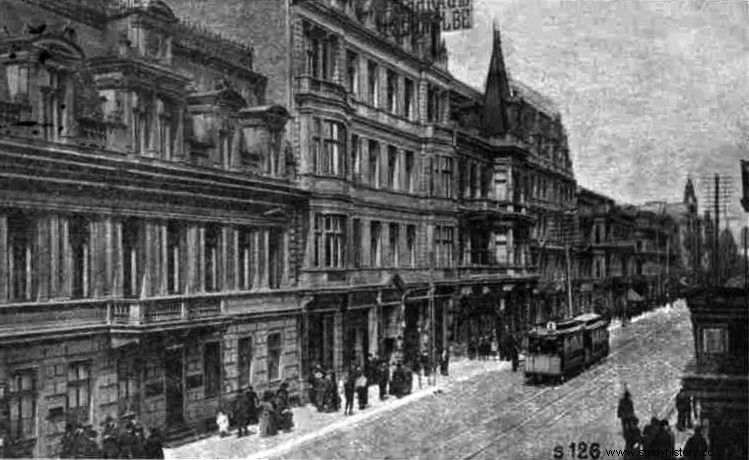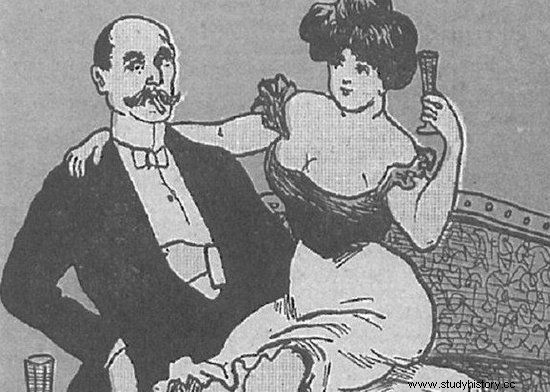"I did not expect such a clean body in a woman earning her grace," said an ordinary Warsaw resident, Marian Sękowski, after an intimate meeting with a prostitute. He knew what he was saying. He found an attractive and well-groomed girl, in a country where prostitutes were almost always ugly, dirty, smelly and starving.
Maria Garówka-Dąbrowska would probably be even more surprised. This forgotten specialist on the dark sides of human nature (she wrote works on poisoners, suicides combined with murder, abortion) conducted an unprecedented study in Polish history.
In 1915, the German occupation authorities ordered the establishment of a special hospital near Łódź, in which over six hundred and fifty local prostitutes were isolated in order to reduce the plague of venereal diseases in the city. The department operated for eight months, and employed, among others, Grzywa-Dąbrowska - at that time a novice, thirty-year-old doctor.
She scrupulously wrote down all her observations about the patients. She conducted detailed interviews with them, and observed their lives and habits day in and day out. She gathered her conclusions in the book The Psychology of Prostitutes published in 1928. And they were not particularly uplifting.

Work or humiliation? A prostitute and her client after "Cupid" (1924). The illustration and caption come from the book by Kamil Janicki “Epoka hypokryzji. Sex and eroticism in pre-war Poland.
We don't want cows, we want meat
According to the author, the prostitutes subjected to observation were childish, lazy, spoiled and incapable of living in society. The vast majority were illiterate. Some of them did not even know how old they were, nor were they able to say how many kopecks were divided into the ruble and how many groszes were divided into the zloty. The possibility of acquiring knowledge under the supervision of doctors did not interest them at all.
Only just over a hundred women decided to take part in the lessons, and less than fifty left the hospital having learned to write and read . They preferred to play or lie in bed all day.
“The favorite [of their games] is a wedding. One of the girls is dressed up as the bride and the other as the groom. There is a wedding procession, sometimes composed of a dozen or so couples. The costumes are very simple:one sheet pinned to the T-shirt with pins replaces the wedding dress, the other, pinned up over the head, is to be a veil (...). The groom and the groomsmen dressed like a man, with a mustache and a beard made of soot or coal "- reported Grzywa-Dąbrowska.

Piotrkowska Street in Łódź in the photo from 1915. It was probably the workplace of many of the 650 prostitutes isolated in the hospital where Maria Grzyw-Dąbrowska worked (source:public domain).
Many similar games ended in fighting. Patients pummeled each other and bit each other. And so until they remembered that the real enemy was the hospital staff. Fights broke out more than once during meals. “We are not cows, so that we are given groats, we want meat,” shouted the prostitutes, throwing cutlery and plates on the ground. It also happened that one of them ran to the faucet, unscrewed it all the way and put a finger in it so as to direct the stream of water directly at the nurses.
If I have syphilis, she can get it too
Nevertheless, the author emphasized that all patients had "good hearts" without exception. For example, they threw their own portions of food through the windows for the poor people who collected branches for firewood near the hospital. Their goodness, however, was - as shown in the account by Grzywa-Dąbrowska - closer to the goodness of small, reckless children than adult women (and some of them were even over forty years old!). They were constantly trembling nervously.
When someone was told that she had to stay in the hospital a few weeks longer because of her illness, would take a pre-prepared vial of iodine or vitriol out of her pocket and threaten to take her own life. "There was even a case of quite serious burns to the mouth in this way" - recalled the doctor. On the other hand, despite the staff's admonitions, sick women went to bed with healthy women. "If I have syphilis, she can get it, too," they said blithely.
They all almost like vodka
More than once in the morning tables and beds were found broken, because the patients suddenly decided to light them in the stove. Theft and frauds were common.
“As for the theft, not a day has passed without one or even a few victims being found. They stole wherever they could. Often, especially on pilgrimage days, they asked to be returned to church ; one of them once openly admitted that she went to church only to "earn" something in the crowd "- wrote Grzywa-Dąbrowska.
They did not like honest work, although they were offered to learn useful professions. We managed to convince about a hundred to participate in the workshops, but most of them soon got bored. The rest fell victim to the harassment of their friends. They have been called to be called by the hospital keepers, they were laughed at for being ugly and that is why they intend to give up prostitution.

Even teenage prostitutes were already addicted to alcohol (source:public domain).
On the other hand, when a handful of really hard-working people were to be rewarded with a commemorative photo, all the others also suddenly decided that they had to be included in the photo confirming that they were sewing and embroidering.
They make the impression of children almost constantly
Prostitutes did not have the heart to work, but they pushed each other to drink. "They almost all like vodka" - emphasized the author. Even fifteen or sixteen-year-old girls begged to be given some alcohol. They did not get, so just like everything else - they stole. Vials of spirit were disappearing from the hospital laboratory over and over again, the only trace of them being brawls and vomit.
"In general, these women almost constantly made an impression of children, and often abnormal beings," emphasized Grzywa-Dąbrowska. The numbers compiled by the author left no room for doubt. She divided her patients into four groups, assessing - in line with the eugenic spirit of the era - the degree of degeneration and hereditary burden of each of them separately.

The reality of life of the overwhelming majority of prostitutes from the turn of the 19th and 20th centuries looked completely different than in the attached picture (source; public domain).
Four groups of psychopaths
The first, most numerous class included "women with a clear psychopathic burden". A total of 34% deserved such a label, including an 18-year-old Catholic girl marked with the initials D.M .:
In the thirteenth year, the patient, persuaded by an older friend, ran away from home. She came to Lodz and found a service here [that is, she was employed as a servant - ed. KJ]. She soon made an acquaintance on the street with some "bachelor" who, having suggested a walk outside the city, raped her in the woods as a result of which she became pregnant at the age of fourteen.
The child is alive; she went for the mum, then the maid. She often changed the service, helping herself with prostitution. The behavior of the patient is very childish (...). One time she decided to escape from the hospital, and when she was interrupted, she quickly climbed a tree to the very top and stayed there for several hours.
Doesn't know how many days a week there are
The second group included "women whose hereditary burden has not been found, but who, however, on the basis of interviews or observations in the hospital, show various psychopathic features". Grzywa-Dąbrowska qualified 10% of patients to this category, for example the 24-year-old Evangelical Sz.O .:
Sick, she doesn't remember her parents, until she was 23, she was grazing cows in the countryside, "wandering around people". As everyone in the village was making fun of her, she decided to move to the city. In Łódź, she got into a shelter (...).
Urged by her friends, she started prostitution However, he cannot answer the question of how long it has been difficult to answer. The patient is illiterate, has no school news, does not know how many days a week, how many months in a year.

Pre-war prostitutes could only dream of big money. The illustration and caption come from the book by Kamil Janicki “Epoka hypokryzji. Sex and eroticism in pre-war Poland.
They prostitute themselves to buy candy
The third group included "women with psychopathic heredity who displayed various psychopathic traits". Up to four - "born" prostitutes. There were many examples of sexual abuse in youth, forced weddings at the age of teenagers, fornication caused by extreme poverty , but also - grown in order to buy sweets. In total, these two groups were estimated by Grzywa-Dąbrowska at 20% of all prostitutes.
Apart from the cases that were difficult to classify, only the last, most optimistic category remained:women "in whom the interviews and observation did not show particularly pathological features". They constituted only 15% of the patients, but even this sad statistic was put by the author with additional reservations.
She emphasized that perhaps the described delinquents did not show any "outstanding" degenerations, but at the same time - none of them was completely sane. The most promising of the six hundred prostitutes were also susceptible to the influence of other people, inability to think independently, lack of respect for other people's property, impulsiveness of reactions and idleness. In a word:every street girl was, quite literally, both morally and mentally a fallen woman.
This vision of prostitution and the women engaged in it was 100% agreed by Polish feminists from the beginning of the 20th century. And for their first, basic postulate, they chose the complete elimination of paid love.
***
Sources:
The article was based on the literature and materials collected by the author during the work on the book The age of hypocrisy. Sex and erotica in pre-war Poland .
